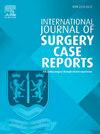出血性心包积液叠加全肺静脉连接异常:首例报告病例。
IF 0.6
Q4 SURGERY
引用次数: 0
摘要
导言:在先天性心脏病(CHD)中,全肺静脉连接异常(TAPVC)约占新生儿心脏畸形的 0.5-2%。出血性心包积液通常由恶性肿瘤和先天性原因引起,但也可能是特发性的:我们介绍一例特殊病例:一名原本健康的年轻男性因胸部不适到我院就诊。检查发现他有大面积出血性心包积液,尽管进行了心包穿刺治疗,但积液仍反复发作了三次。进一步检查发现该患者患有 TAPVC,经手术修补后症状缓解:讨论:TAPVC 如果在一岁前得不到修复,死亡率高达 80%。TAPVC的心上型和存在房间隔缺损(ASD)是影响存活率的因素。成人 TAPVC 未修复时同时出现出血性心包积液的情况并不常见。出血性心包积液的消退表明这两种疾病可能存在关联:我们的病例引起了人们的注意,因为现有的医学文献很少报道这种独特的病例。医护人员应该对成人 TAPVC 未修复时可能出现的叠加性出血性心包积液保持警惕。本文章由计算机程序翻译,如有差异,请以英文原文为准。
Hemorrhagic pericardial effusion superimposed on total anomalous pulmonary venous connection: First-reported case
Introduction
Among congenital heart diseases (CHD), total anomalous pulmonary venous connection (TAPVC), constitutes approximately 0.5–2 % of all detected cardiac anomalies in newborns. Hemorrhagic pericardial effusions are frequently caused by malignancy and iatrogenic cause; however, they can be idiopathic.
Presentation of case
We introduce an exceptional case of a previously healthy young adult male who sought medical attention at our institution due to chest discomfort. Investigation revealed a large hemorrhagic pericardial effusion, which recurred three times despite treatment with pericardiocentesis. Further investigation revealed a TAPVC, which subsequently resolved following surgical repair.
Discussion
TAPVC carries a mortality rate of up to 80 % if unrepaired by one year of age. The supracardiac type of TAPVC and presence of atrial septal defect (ASD) are factors that contribute to survival. The simultaneous occurrence of hemorrhagic pericardial effusions in the setting of unrepaired TAPVC in adults is uncommon. The resolution of the hemorrhagic pericardial effusion suggests a possible association between the two disease entities.
Conclusion
Our case draws attention due to the scarcity of available medical literature reporting such a unique occurrence. Providers should remain vigilant regarding a possible superimposed hemorrhagic pericardial effusion, which could develop in the setting of unrepaired TAPVC in adults.
求助全文
通过发布文献求助,成功后即可免费获取论文全文。
去求助
来源期刊
CiteScore
1.10
自引率
0.00%
发文量
1116
审稿时长
46 days

 求助内容:
求助内容: 应助结果提醒方式:
应助结果提醒方式:


